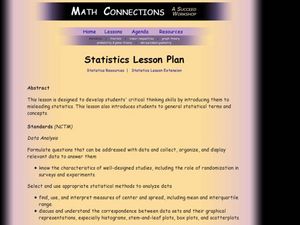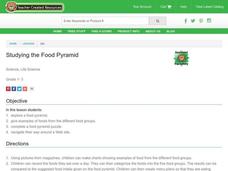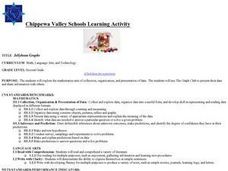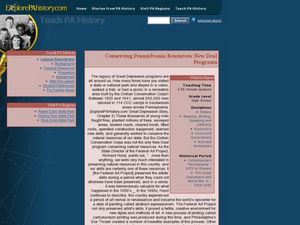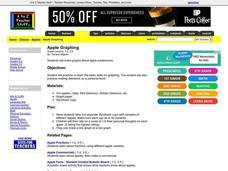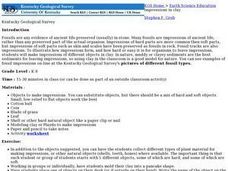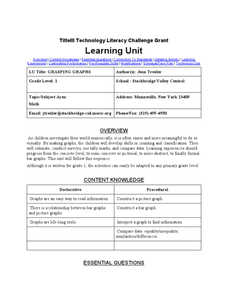Curated OER
Unknown Vocabulary
Students develop the vocabulary necessary to make their reading meaningful. After creating pre-reading activities, students a list of unknown vocabulary related to their reading selection. They complete vocabulary and context...
Curated OER
Making Babies
Young scholars participate in a genetics activity in which they determine genotypes and phenotypes for given traits. They work with a partner and create babies based on their genotypes. Once traits for babies are determined, they write...
Curated OER
Statistics: Misleading or Accurate?
Students explore the concept of misleading statistics. In this misleading statistics lesson plan, students play a game of tag and graph the number of times each student gets tagged. Students use the graph to determine the fastest...
Curated OER
Don't Forget the Three R's
Students encourage one another in recycling. In this environment and art instructional activity, students create a new recycling bin that would help people in remembering to recycle.
Curated OER
Gathering, Recording, and Presenting Data
Sixth graders use the local newspaper to find and discuss examples of uses of statistics and the ways in which the information is presented. They create and represent their own set of data showing how students get to school each day.
Curated OER
Persuading the Assembly
Young scholars critique a power point presentation. They create power point presentation.
Curated OER
Studying the Food Pyramid
Young scholars have a cooking day. In this healthy eating lesson, students use pictures from a magazine to illustrate the food groups. Young scholars record the foods they eat and then see if they are eating enough from each food group....
Curated OER
Your Politician: Myth vs. Reality
Pupils adopt a public official, research how they spend their time, and define the actual duties associated with the job. They sort perceptions about the job into myths and realities, and analyze political cartoons involving their official.
Curated OER
Histograms and Statistical Graphics
In this statistics worksheet, young scholars solve 6 data problems. They construct a histogram of given data, they create a frequency polygon, and a stem and leaf diagram. Students create a dot plot and a pie chart for given data sets....
Curated OER
Jellybean Graphs
Second graders predict and graph data based on the color of jelly beans they think are in a handful. In this prediction lesson plan, 2nd graders will predict how many of each color jellybean are in a handful. Then they graph these...
Curated OER
Conserving Pennsylvania Resources: New Deal Programs
Students analyze the impact of the New Deal programs in Pennsylvania. In this Great Depression lesson, students examine the New Deal programs and their legacies in Pennsylvania. They relate these programs to the preservation of national...
Curated OER
Sanctuary: Quail Island Banks
Learners explore visual arts by examining a diorama in class. In this geography lesson, students examine an island off the coast of New Zealand and identify the physical attributes of the land. Learners answer study questions...
Curated OER
Arrange the Classroom (Part 1 of 3)
Fifth graders arrange the classroom using all the moveable objects and through the exploration of area and perimeter. They determine the area of the classroom, create and label model pieces of furniture using graph paper, and create a...
Curated OER
Proof of the Primate-ive Roots of AIDS
Students explore recent breakthroughs in H.I.V. and AIDS research, as well as research various epidemics that have devastated the world population at various points in history.
Curated OER
Using Computers to Produce Spreadsheets and Bar Graphs
Students review graphing terminology and how to plot data points, how to input data into a spreadsheet, and how to make a chart using a computer.
Curated OER
A Snapshot of the Connecticut River Valley - 1880
Students analyze a variety of images and documents and make inferences from their readings and articulate causality.
Curated OER
Apple Graphing
Students sample a variety of types of apples and then survey each other regarding their favorites. They chart how many students prefer each type of apple.
Curated OER
Impressions in Clay
Students examine how fossils are created. They make impressions of different objects in clay and compare them to examples of fossils.
Curated OER
Candle-Wax Fossils: Casts, Molds, and Impressions
Young scholars examine and define fossils. They create their own impressions and molds in clay and candle wax, making external and internal molds.
Curated OER
Fraction Feast!
Students listen to various books about sharing food or food fractions. Then they discuss their fraction feast, examining the food and deciding how it can be shared to make fractions.
Curated OER
Mapping Los Angeles over Time
Young scholars read maps for chronological information in Los Angeles. They develop a multicultural chronology of Los Angeles.
Curated OER
Recognizing a Message's Point of View
Students study the physical, mental, and social health benefits of regular exercise while attempting to recognize the point of view of media messages. They read an article and discern ways in which they can make regular exercise a part...
Curated OER
Demystifying Mood in Creative Writing
Learners discover how writing is affected by mood and emotions. They learn proper mood descriptors and read sample pieces of writing to better explain mood.
Curated OER
Technology Literacy Challenge Grant Learning Unit
First graders explore counting and classification. They sort leaves, create graphs, write sentences for the data in the graphs, develop graphs for shapes, favorite animals, birthdays, and participate in a die prediction game.


